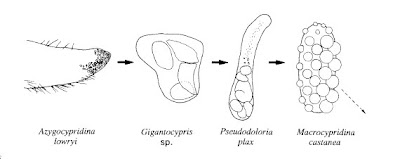The spring/summer before moving to Duke University to start working for my PhD, I was thinking about what I would do for my thesis. At that time, I was already interested in testing comparative methods aimed at estimating what extinct species might have been like, the methods are called "ancestral state reconstruction". Well, one part of the project was to work on a phylogeny of viruses that was evolved in the lab. The actual ancestors were preserved in the refrigerator, so I could estimate these ancestors using the existing methodologies.
In addition to the virus study, I wanted to do a similar exercise with a group of organisms that have a good fossil record, and compare estimated ancestors to the fossil record. So, I wrote my advisor-to-be, to ask if he could recommend a group with a good fossil record. The email came back with the title "Ostrocads are it!!". Cliff had accidentally inverted the o and the a in "ostracods".
Once I figured out what is an ostrocad, the first paper I came across was by Andrew Parker, who would later help me in many ways by email, as well as in person when I collected ostracods in Australia. Here is a news story about us, with a photo taken near Sydney.
Andrew's paper was entitled "Discovery of functional iridescence and its coevolution with eyes in the phylogeny of Ostracoda (Crustacea)". In it, he suggested "The myodocopid lateral eye probably evolved at a similar point in time as iridescence, possibly to detect iridescence. The graduations by which the ostracod compound eye has developed are suggested. These findings challenge current theories which demand a single evolution of the compound eye."
These provocative statements would lead to the bulk of my dissertation, which tested Andrew's ideas using molecular phylogenetics and ancestral state reconstruction.
The "graduations" Andrew suggests are illustrated in his figure 5. His caption begins "Possible means of derivation of the myodocopid compound eye."

This is a perfect example of linear thinking, versus tree thinking. Laid out are 3 living species of myodocopid ostracods; all from the same family. These are used to represent a linear, graduated series from a simple eye in Azygocypridina, to a complex compound eye in Macrocypridina.
No comments:
Post a Comment